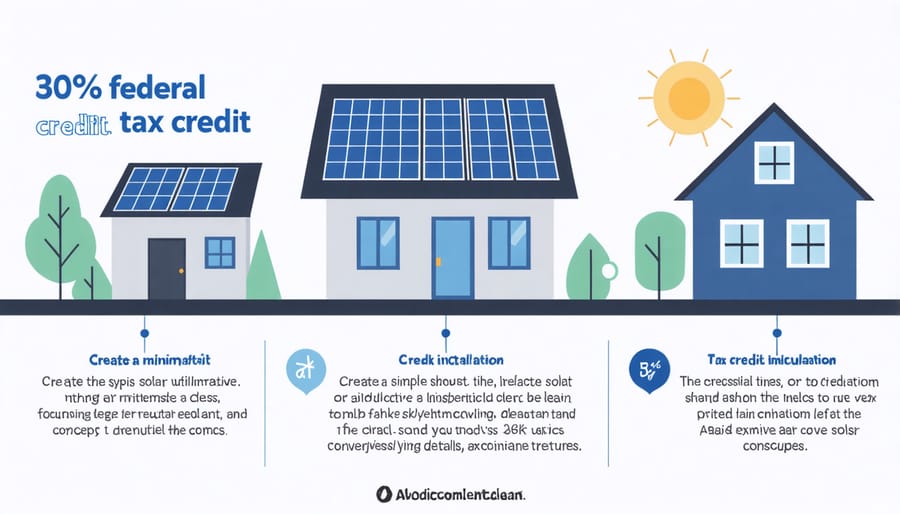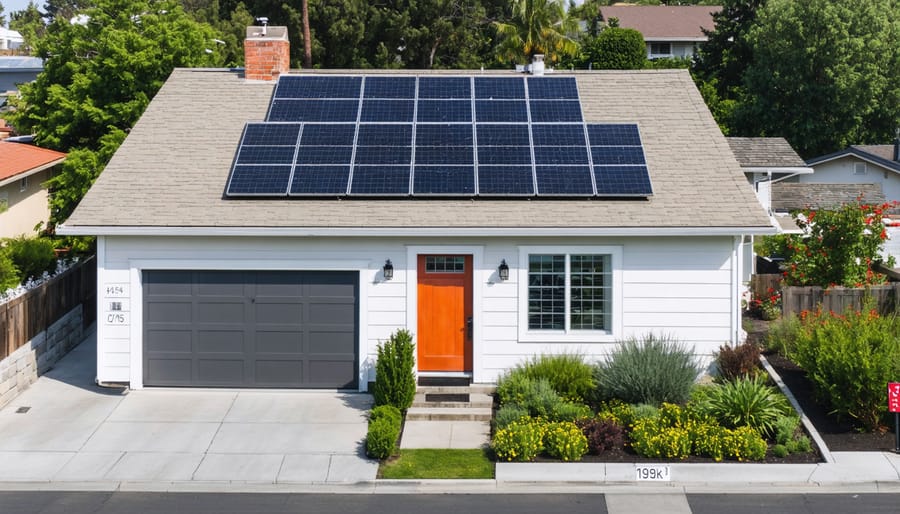California homeowners can now slash their energy costs by up to 30% through the federal solar tax credit while accessing thousands in additional state rebates and incentives. The Golden State leads the nation in solar adoption, offering an impressive array of financial incentives that make residential solar installations more affordable than ever. From the Self-Generation Incentive Program (SGIP) to local utility rebates and property tax exclusions, California’s solar incentive landscape provides multiple pathways to significant savings.
The combination of falling solar panel costs and generous incentive programs has created an unprecedented opportunity for homeowners to transition to clean energy while boosting their property values. Whether you’re looking to eliminate your monthly electricity bills, protect against future rate hikes, or contribute to California’s ambitious clean energy goals, understanding these incentives is crucial for maximizing your solar investment. With many programs operating on a first-come, first-served basis and some incentives scheduled to decrease over time, now presents an optimal moment to explore solar options for your home.
This comprehensive guide breaks down the current incentives available to California residents, helping you navigate the various programs and ensure you receive every financial benefit you qualify for.
Federal Solar Tax Credit: The Foundation of Solar Savings

How the Federal Tax Credit Works
The federal solar tax credit, also known as the Investment Tax Credit (ITC), offers a straightforward way to reduce your solar installation costs. For a detailed breakdown, check out our comprehensive federal solar tax credit guide. Here’s how to claim it:
First, ensure you qualify by owning (not leasing) your solar system and having sufficient tax liability. Keep all receipts and documentation from your solar installation. When tax season arrives, complete IRS Form 5695 to calculate your credit amount. The credit equals 30% of your total solar system costs, including installation.
Add this amount to Form 1040 when filing your taxes. If your tax liability is less than the credit amount, you can carry over the remaining credit to the following year. For example, if your solar system costs $20,000, you’re eligible for a $6,000 tax credit.
Remember, this is a tax credit, not a deduction – meaning it reduces your tax bill dollar-for-dollar. The process is straightforward, but consulting with a tax professional can ensure you maximize your benefits.
Qualifying Requirements
To qualify for California’s solar incentives, you’ll need to meet several straightforward requirements. First, you must own your home and have it located within California. The solar system must be new and installed by a licensed contractor certified by the North American Board of Certified Energy Practitioners (NABCEP).
Your roof should be in good condition and receive adequate sunlight throughout the day. Most programs require a minimum system size of 1 kilowatt (kW), though optimal sizing depends on your household’s energy needs. You’ll also need to maintain an active account with your local utility company.
Required documentation typically includes:
– Proof of homeownership
– Recent utility bills
– Solar system design plans
– Signed contract with your installer
– Building permits from your local jurisdiction
– Documentation of system costs
Some specific programs have additional requirements. Low-income households may need to provide income verification, while PACE financing programs require proof of property tax payment history. It’s recommended to work with your solar installer to ensure all paperwork is properly completed before installation begins.
California-Specific Solar Incentives
Net Energy Metering (NEM)
Net Energy Metering (NEM) is one of California’s most valuable solar incentives, allowing homeowners to earn credits for the excess solar energy they send back to the grid. Under this program, your utility company tracks both the electricity you consume and the surplus power your solar panels generate, essentially using the grid as a virtual battery.
Currently, California operates under NEM 2.0, but the state is transitioning to NEM 3.0 for new solar customers starting in April 2023. While this update reduces some benefits compared to previous versions, it still offers significant value for homeowners going solar. Under NEM 3.0, excess energy credits are calculated based on the “avoided cost” rate, which varies by time of day and season.
To maximize benefits under the new system, consider pairing your solar installation with battery storage. This allows you to store excess energy for use during peak rate hours when grid electricity is most expensive. While export rates are lower under NEM 3.0, the program still enables substantial savings on electricity bills.
The program guarantees these benefits for 20 years from your solar system’s installation date, providing long-term financial security. Even with recent changes, NEM remains a cornerstone of California’s solar incentive structure, making solar adoption financially attractive for homeowners.


SGIP Rebate Program
California’s Self-Generation Incentive Program (SGIP) offers substantial rebates for homeowners who install energy storage systems alongside their solar panels. This program, administered by the California Public Utilities Commission, helps offset the cost of battery storage systems like the Tesla Powerwall or LG Chem RESU.
The SGIP provides tiered incentive rates based on battery capacity, with higher rebates available for residents in high-fire-threat districts or those who rely on medical devices. Currently, basic SGIP rebates can cover up to $200 per kilowatt-hour of installed battery capacity. For eligible households in vulnerable communities or those affected by Public Safety Power Shutoffs (PSPS), the rebate can increase to $1,000 per kilowatt-hour through the equity resiliency budget.
To qualify, homeowners must be customers of Pacific Gas and Electric (PG&E), Southern California Edison (SCE), Southern California Gas Company (SoCalGas), or San Diego Gas & Electric (SDG&E). The battery system must be able to discharge for at least two hours and meet minimum round-trip efficiency requirements.
The application process is straightforward, typically handled by your solar installer or battery provider. Funds are distributed on a first-come, first-served basis, so it’s recommended to apply as soon as you decide to install a battery system. This incentive can be combined with other solar incentives, making energy storage significantly more affordable for California homeowners.
Local Utility Rebates
California’s major utility companies offer various rebate programs to encourage solar adoption across different regions. Pacific Gas and Electric (PG&E), serving Northern California, provides performance-based incentives for solar installations, with additional bonuses for energy storage systems. Southern California Edison (SCE) customers can benefit from their Smart Home Program, which offers rebates for integrated solar and smart home technologies.
San Diego Gas & Electric (SDG&E) maintains a comprehensive solar rewards program, offering incentives based on system size and expected performance. Sacramento Municipal Utility District (SMUD) provides upfront rebates to homeowners who install solar panels, with extra incentives for those who participate in their virtual power plant program.
Many municipal utilities also offer their own unique incentives. For example, the Los Angeles Department of Water and Power (LADWP) provides rebates through their Solar Incentive Program, while Anaheim Public Utilities offers cash incentives for both solar installations and battery storage systems.
To maximize your benefits, check with your local utility provider, as programs and rebate amounts are updated regularly. Most utilities also offer additional incentives for low-income households or specific neighborhoods to promote equitable access to solar energy. Remember to apply for these rebates early in your solar journey, as some programs have limited funding or operate on a first-come, first-served basis.
Low-Income Solar Programs
DAC-SASH Program
The DAC-SASH Program, or Disadvantaged Communities-Single-family Solar Homes Program, offers significant financial support to low-income homeowners in California’s disadvantaged communities. This initiative provides substantial upfront rebates that can cover up to 100% of solar system costs for qualifying households.
To be eligible, homeowners must live in a designated disadvantaged community, own and occupy their home, and have a household income that’s 80% or less than the area median income (AMI). The program also requires participants to receive electricity from one of California’s three major investor-owned utilities: Pacific Gas and Electric (PG&E), Southern California Edison (SCE), or San Diego Gas & Electric (SDG&E).
What sets DAC-SASH apart is its comprehensive approach to solar adoption. Beyond financial assistance, the program includes energy efficiency education and workforce development opportunities. Local contractors participating in the program must hire from disadvantaged communities, creating job opportunities while building clean energy infrastructure.
The program is administered by GRID Alternatives, a non-profit organization that helps guide homeowners through the application process and ensures quality installation standards are met.
CARE/FERA Program Benefits
California’s CARE (California Alternate Rates for Energy) and FERA (Family Electric Rate Assistance) programs work seamlessly with solar incentives to maximize savings for eligible households. If you qualify for either program based on household size and income, you can still take full advantage of solar incentives while enjoying reduced electricity rates.
When combined with solar installation, CARE and FERA participants often experience enhanced benefits. The reduced electricity rates these programs offer apply to any grid electricity you need to purchase when your solar panels aren’t producing enough power, such as during nighttime or cloudy days. This means you’ll pay less for backup power while your solar system generates free electricity during peak hours.
Additionally, if your solar system produces excess energy, you’ll receive credits on your utility bill at the same favorable CARE/FERA rates through net metering. This dual benefit of discounted rates and solar incentives can significantly accelerate your return on investment in solar panels. For income-qualified households, this combination of programs makes solar energy more accessible and affordable than ever before.
Property Tax Exclusion
California offers a significant financial benefit for homeowners installing solar systems through its property tax exclusion policy. When you add solar panels to your home, the value of your property typically increases. However, unlike other home improvements, the added value from your solar installation won’t increase your property tax bill.
This exclusion, established by the California Revenue and Taxation Code Section 73, ensures that solar energy systems installed between January 1, 2020, and December 31, 2024, are exempt from property tax assessments. This means you can enjoy the increased home value that solar panels bring without paying higher property taxes.
The exclusion covers active solar energy systems, including photovoltaic panels, solar water heating systems, and storage batteries when part of the solar installation. It applies to both new construction and existing homes, whether the system is purchased outright or acquired through a lease agreement.
For homeowners, this represents substantial long-term savings, as property tax increases on solar improvements could otherwise amount to hundreds of dollars annually. The exclusion remains in effect until the property changes ownership, ensuring predictable tax obligations throughout your ownership of the home.
To benefit from this exclusion, you don’t need to file any additional paperwork – it’s automatically applied when your solar system is installed. This makes it one of the most straightforward and hassle-free solar incentives available to California residents.
Maximizing Your Solar Incentives
To make the most of California’s generous solar panel incentives, timing and strategic planning are essential. Start by combining the federal tax credit with California’s Net Energy Metering program to maximize your savings. Installing your system before any announced incentive reductions is crucial – many programs operate on a first-come, first-served basis with declining benefit rates.
Consider scheduling your installation during the off-season (typically fall or winter) when installers may offer additional discounts. Before finalizing your solar project, check with your local utility company for any special rebate programs or time-of-use rate plans that could enhance your savings.
Don’t forget to explore multiple financing options, including PACE programs and solar loans, which can be combined with other incentives. If you qualify for income-based programs like SASH or DAC-SASH, apply for these first as they offer the most substantial benefits.
Keep detailed records of all your solar-related expenses and ensure your installer provides proper documentation for incentive applications. Working with a certified solar provider familiar with California’s incentive landscape can help you navigate the paperwork and deadlines effectively.
Remember to check municipality-specific programs in your area, as local governments often provide additional rebates that can stack with state and federal incentives.
California’s residential solar incentives offer an unprecedented opportunity to embrace clean energy while securing significant financial benefits. By combining federal tax credits, state rebates, and local incentives, homeowners can substantially reduce their initial installation costs and achieve impressive long-term savings on their energy bills.
The time to act is now, as many of these incentives operate on a declining schedule or have limited funding. With the 30% federal tax credit, NEM 3.0 program, SGIP rebates, and various local incentives, California residents have access to one of the most comprehensive solar support systems in the nation. These programs not only make solar more affordable but also contribute to increasing your property value and reducing your carbon footprint.
Remember that solar installation is a long-term investment in your home’s future. While the initial costs might seem substantial, the combination of available incentives and ongoing energy savings typically results in a payback period of just 4-6 years for most California homeowners. After that, you’ll enjoy decades of reduced energy costs and energy independence.
Don’t let these opportunities pass you by. Contact qualified solar installers to get personalized estimates and learn exactly which incentives you qualify for. By taking action today, you’re not just making a smart financial decision – you’re joining California’s movement toward a more sustainable future while securing your energy independence for years to come.









